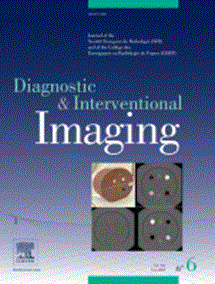Image quality and dose reduction with photon counting detector CT: Comparison between ultra-high resolution mode and standard mode using a phantom study
IF 8.1
2区 医学
Q1 RADIOLOGY, NUCLEAR MEDICINE & MEDICAL IMAGING
引用次数: 0
Abstract
Purpose
The purpose of this study was to assess the image quality and dose reduction potential of ultra-high resolution (UHR) mode compared with standard mode, both available on a commercial photon-counting detector computed tomography (PCCT) scanner.
Materials and methods
Images were acquired on a PCCT with a phantom using UHR and standard modes at three dose levels (3/6/12 mGy). Raw data were reconstructed using soft tissue (Br36) and bone (Br68) reconstruction kernels and 0.4-mm slice thickness. Noise power spectrum (NPS) and task-based transfer function (TTF) were calculated to assess noise magnitude, noise texture (fav), and spatial resolution (f50), respectively. Detectability indexes (d’) were calculated to model the detection of two abdominal lesions for a Br36 soft tissue reconstruction kernel and three bone lesions for a Br68 bone reconstruction kernel.
Results
At all dose levels, noise magnitude values were lower with UHR than with standard mode (mean difference, -18.0 ± 2.6 [standard deviation (SD)] % for Br36 and -33.9 ± 2.3 [SD] % for Br68). Noise texture was lower with UHR than with standard mode (mean difference, -4.2 ± 0.9 [SD] % for Br36 and -16.0 ± 1.8 [SD] % for Br68). For the solid water insert and Br36, f50 values were similar for both UHR (0.34 ± [SD] 0.04 mm-1) and standard (0.33 ± [SD] 0.04 mm-1) modes. For Br68, f50 values were greater with UHR than with standard for iodine (mean difference, 18.5 ± 1.9 [SD] %) and bone (11.7 ± 5.7 [SD] %) inserts. For all simulated lesions, d’ values were greater with UHR than with standard and, compared to standard, the dose reduction potential with UHR was -32.9 ± 0.0 (SD) % for abdominal lesions and -68.7 ± 3.2 (SD) % for bone lesions.
Conclusion
Compared to the standard mode, the UHR mode offers lower noise levels and better detectability of abdominal and bone lesions, paving the way for potential dose reduction with PCCT in clinical applications.
光子计数检测器CT的图像质量和剂量减少:超高分辨率模式和标准模式的比较。
目的:本研究的目的是评估超高分辨率(UHR)模式与标准模式的图像质量和剂量减少潜力,两者都可以在商用光子计数检测器计算机断层扫描(PCCT)扫描仪上获得。材料和方法:使用UHR和标准模式,在三个剂量水平(3/6/12 mGy)下,在带假体的PCCT上获取图像。原始数据采用软组织(Br36)和骨(Br68)重建核,切片厚度为0.4 mm。计算噪声功率谱(NPS)和基于任务的传递函数(TTF),分别评估噪声强度、噪声纹理(fav)和空间分辨率(f50)。计算可检测性指数(d')来模拟Br36软组织重建核的2个腹部病变和Br68骨重建核的3个骨病变的检测。结果:在所有剂量水平下,UHR的噪声值均低于标准模式(Br36的平均差值为-18.0±2.6[标准差(SD)] %, Br68的平均差值为-33.9±2.3 [SD] %)。与标准模式相比,UHR模式下的噪声纹理较低(Br36的平均差值为-4.2±0.9 [SD] %, Br68的平均差值为-16.0±1.8 [SD] %)。固体水插入剂和Br36在UHR(0.34±[SD] 0.04 mm-1)和标准(0.33±[SD] 0.04 mm-1)模式下的f50值相似。对于Br68, UHR的f50值高于标准碘(平均差值为18.5±1.9 [SD] %)和骨(11.7±5.7 [SD] %)插入物。对于所有模拟病变,UHR的d'值大于标准,与标准相比,UHR对腹部病变的剂量减少潜力为-32.9±0.0 (SD) %,对骨骼病变的剂量减少潜力为-68.7±3.2 (SD) %。结论:与标准模式相比,UHR模式噪音水平更低,对腹部和骨骼病变的可检出性更好,为PCCT在临床应用中的潜在减剂量铺平了道路。
本文章由计算机程序翻译,如有差异,请以英文原文为准。
求助全文
约1分钟内获得全文
求助全文
来源期刊

Diagnostic and Interventional Imaging
Medicine-Radiology, Nuclear Medicine and Imaging
CiteScore
8.50
自引率
29.10%
发文量
126
审稿时长
11 days
期刊介绍:
Diagnostic and Interventional Imaging accepts publications originating from any part of the world based only on their scientific merit. The Journal focuses on illustrated articles with great iconographic topics and aims at aiding sharpening clinical decision-making skills as well as following high research topics. All articles are published in English.
Diagnostic and Interventional Imaging publishes editorials, technical notes, letters, original and review articles on abdominal, breast, cancer, cardiac, emergency, forensic medicine, head and neck, musculoskeletal, gastrointestinal, genitourinary, interventional, obstetric, pediatric, thoracic and vascular imaging, neuroradiology, nuclear medicine, as well as contrast material, computer developments, health policies and practice, and medical physics relevant to imaging.
 求助内容:
求助内容: 应助结果提醒方式:
应助结果提醒方式:


